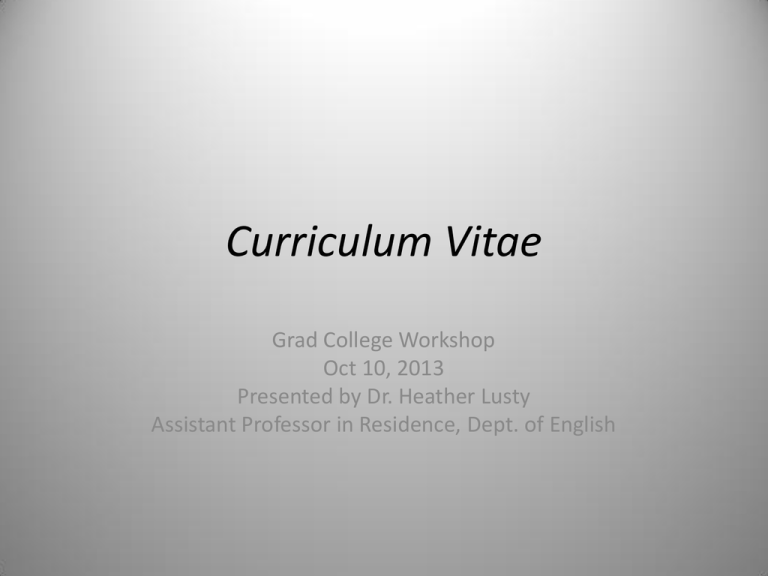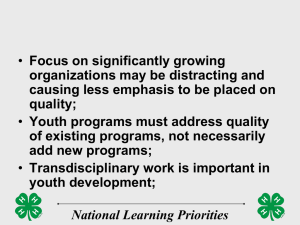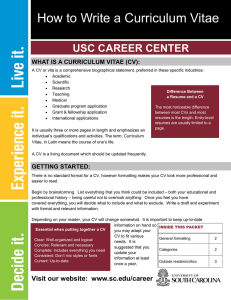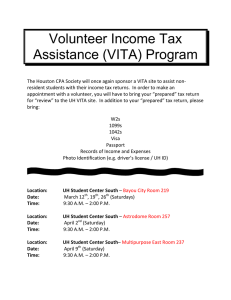CV Preparation PPT
advertisement

Curriculum Vitae Grad College Workshop Oct 10, 2013 Presented by Dr. Heather Lusty Assistant Professor in Residence, Dept. of English The Vita The vita is always the first thing you send to a hiring institution. Hiring committees may only spend 15 seconds scanning your vita initially. Design your vita so that your strongest qualifications stand out, and enough supporting detail to stand up to a closer reading. Grad School “Experience” • • • • • Getting started: Review your • educational and professional history, & list everything/anything • that you could possibly include • (trim later) • What have you done? • Depending on your field, you may • have a lot of experience in various areas that can accentuate your flexibility TA/teaching Research team/writing Workshops/certifications Invited talks Conference/other presentations GPSA Research Forums Publications (divisions) Journal editing Committee work Tutoring Professional affiliations Standard Content Name, contact info (public/private) Education Honors/awards/grants Professional Experience Publications Presentations Professional, extracurricular, or community activities Teaching competencies Service Name/Contact Name (slightly larger) at top of page Home and university contact information • Home & university address, e-mail, phone, and web site URL (if applicable) • Consider CV on public site versus search committee (remove personal contact info) • Name change? Jane E. (Doe) Smith • Last name & page number should appear in header or footer on each page Education • List each institution, degree, field of concentration, and date of degree confirmation • Dissertation (anticipated date if not completed) – – – – Title of dissertation & name of advisor Names of committee (only if it will help) Additional research projects/areas of concentration Activities related to your graduate training (e.g., President, Graduate Chemistry Society) – Omit undergrad & high school info altogether • Honors – If you’ve received prestigious/competitive awards, they may warrant a separate section here • Includes dissertation fellowships & awards – If you don’t have awards, don’t draw attention to them with a separate section Experience Include anything relevant to your professional objectives For each position, list • Name of the institution affiliated with • Job title • Dates employed/in residence • Responsibilities and accomplishments – Make your words count; use verb phrases. For example: • [Bad] “Responsibilities included developing various new course materials and instructional aids” • [Good] “Developed syllabus and diagnostic exam later adopted by department” • Divide “Teaching Experience” from “Research Experience” (if applicable) Professional (field) Experience • If you are applying for a position in a professional school (law, dental, architecture) and have experience of any time working in that profession, create a subcategory and describe it in detail • If your professional experience is NOT related to your current scholarly pursuits, include it (drastically condensed) • Licensure/Registration/Certification – List these credentials for positions in professional schools where they are required (e.g., nursing, education, architecture) Publications • Listed in standard bibliographic form (field specific) • If list is long, subcategorize by topic or publication format (calls attention to areas of expertise that may not be readily apparent) • Listing articles as “Submitted” or “Under Review” and “In preparation” is acceptable, but too many of this form not balanced by articles already published or in press looks desperate • Separate publications by categories (if applicable): – – – – peer reviewed articles (most important category) co-written publications (more acceptable in social & physical sciences) invited contributions (to textbooks, encyclopedia entries, etc.) book reviews, conference reports • Be aware of prestige hierarchies – Articles in refereed journals rate more highly than term papers or publications in popular journals or newspapers (leave these out if you have legitimate conference presentations/ publications) – Don’t pad publications list (and don’t include anything you don’t want a hiring committee to dig up and read) Presentations (Research/Conference) Presentations at scholarly conventions/societies are generally considered more important than local or popular conferences – What are your field’s “major” conventions? These should get preferential treatment/consideration. – Are there regional branch meetings for which it may be easier to get a presentation accepted? – Early on, you may list roundtable panels, seminar groups, etc., but these less formal participatory aspects should be pruned as you build your formal conference presentations list. – Outside area presentations (archaeology, Classics, solar energy) should be included if they highlight areas of interest/ongoing research that show your diversity and flexibility (but don’t make you look indecisive or spread too thin). – Consider guest lectures, research presentations, etc. Grants • If you’ve received funding, list the funding agency and the project for which it was awarded. • Candidates frequently list dollar amounts for major funded research projects • Fellowship or dissertation support should be listed under “Honors” • Don’t double list grants Scholarly/Professional Memberships • List memberships and/or committee work in scholarly or professional organizations. • If you’ve been very active in university related committees, list them here (GPSA, organizing or moderating conference sessions, honors societies) • Research Interests (optional) – What are your future research plans? • Describe at a level specific enough to be credible and general enough to indicate the direction your research might take over the next several years • You may also be asked to submit a brief (one or two page) discussion of your future research plans as a separate part of your application Teaching Competencies (optional) • Optional category if you feel the areas your are qualified to teach are not obvious from the rest of the entries in your vita – E.g., I am proficient in German and Old English, and familiar with Middle English, so I might highlight my interest in teaching a department core class: History of the English Language • Don’t list so many competencies that your list lacks credibility (it’s not a wish list) • If you list a subject as a teaching competency, some other part of the vita should reinforce your qualifications to teach it • If you list specific courses, be prepared to discuss a syllabus and texts for them Additional Information • Service – Graduate or professional associations, service, etc. – University committees (e.g., Writing links program, accreditation word, general education reform) – Mentoring/tutoring – Advising (undergraduate thesis committees) – Field conferences (organizing/hosting, staffing, etc) • Personal – Optional section where you may include miscellaneous information that does not fit elsewhere • Foreign languages • Extensive travel • Interests you feel important • References – These should be listed (with contact information) on a separate sheet; include if required (usually these are uploaded separately in application portals) – Services like Interfolio provide secure, third party reference letter storage (as well as application materials) and send confidential letters on order (www.interfolio.com) Tailoring your vita to an Audience • Always include basic info • Different positions may require different emphases – Teaching vita (emphasizes range of courses taught and/or developed) • Community & small liberal arts or tech colleges • Private preparatory schools • Business/marketing training positions – Research vita (emphasizes scholarly pursuits over teaching or service) • Most universities • Private research institutions/companies – Administrative/Advisory vita (if you want to transition into administration, most of your experience is still relevant and important) • Civil service • Government positions (foreign service, NSA, etc) Layout and Reproduction • Format (clean, clear) is always important • Most important info goes on first page (motivate them to turn the page) • Spatially, the top half of the page gets more attention than the lower, and the left column gets more attention than the right (just something to keep in mind) • Use a consistent graphic hierarchy: – Bold type is for emphasis – Headers should be ALL CAPS (don’t also underline and/or bold – it’s redundant) – Use one (at most two) conservative fonts (not something really cool that expresses the inner you) – Proofread, proofread, proofread – then ask someone else to look for typos, spelling errors, inconsistent spacing, date format consistency, etc. A simple error on your CV shows that you aren’t attentive to detail and concerned about appearances. – Use your department faculty: ask them for comments/critiques on your CV. Their knowledge of field specific trends can be invaluable! Sample 1: Post Doc CV Sample 2: Social Sciences Sample 3: Sciences Recommended Reading References Duke University. Student Affairs: Curriculum Vitae. Accessed 3 October 2013. <http://studentaffairs.duke.edu/career/online-tools-resources/careercenter-skills-guides/curriculum-vitae>. Medical College of Wisconsin. Student Affairs: Sample CVs. 2013. Accessed 3 October 2013. <http://www.mcw.edu/medicalschool/studentaffairs/Residency-MatchProcess/Curriculum-Vitae-Samples.htm>. The Academic Job Search Handbook 4th Ed. Vick, Julia Miller & Jennifer S. Furlong. Philadelphia: University of Pennsylvania Press, 2008.


